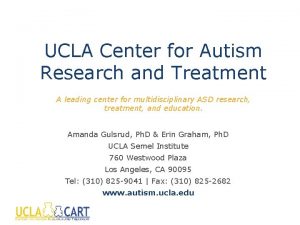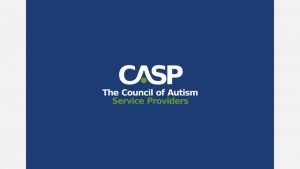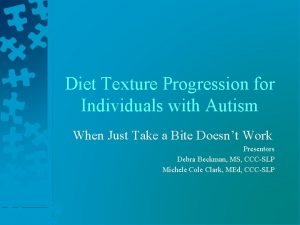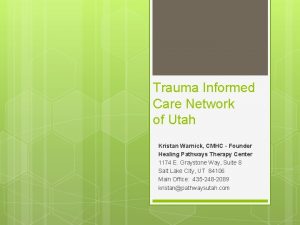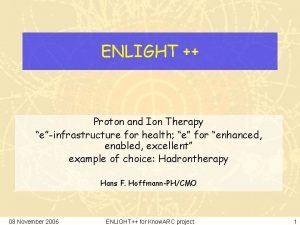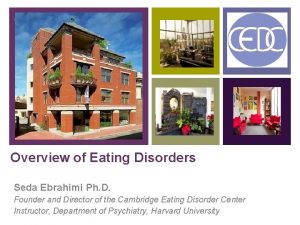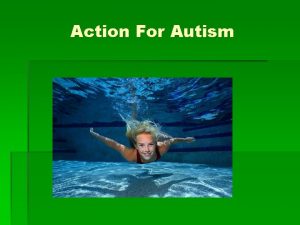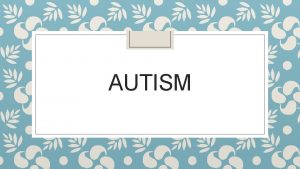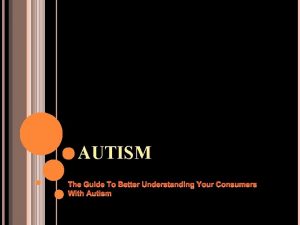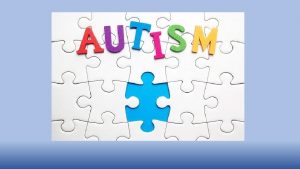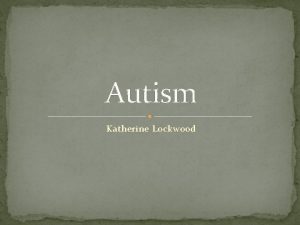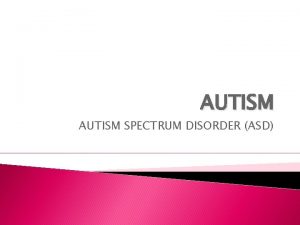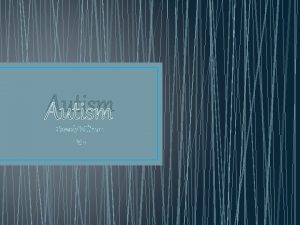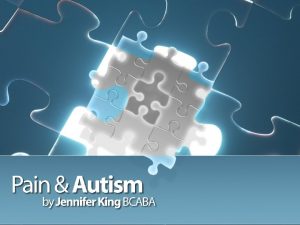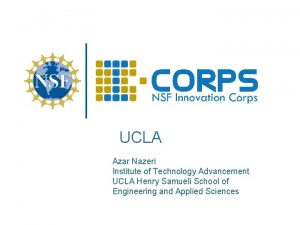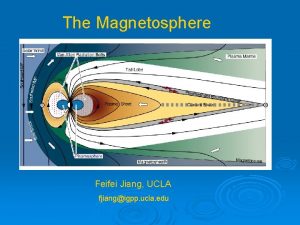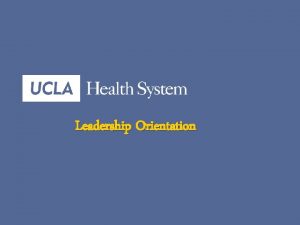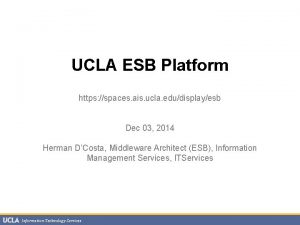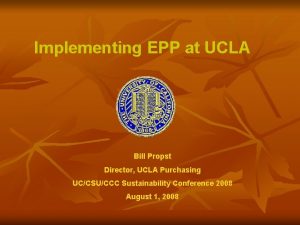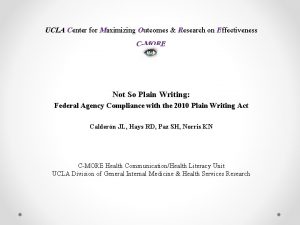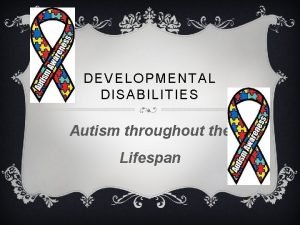UCLA Center for Autism Research and Treatment A
























- Slides: 24

UCLA Center for Autism Research and Treatment A leading center for multidisciplinary ASD research, treatment, and education. Amanda Gulsrud, Ph. D & Erin Graham, Ph. D UCLA Semel Institute 760 Westwood Plaza Los Angeles, CA 90095 Tel: (310) 825 -9041 | Fax: (310) 825 -2682 www. autism. ucla. edu

Presentation Overview • What is Autism Spectrum Disorder and Why Does it Matter? • What is UCLA CART? • What does UCLA CART have to offer in the community?

What is Autism Spectrum Disorder? • Autism Spectrum Disorder (ASD) is a disorder of brain development • Onset in childhood; continues into adulthood • Children and adults with ASD may communicate, interact, behave, and learn in ways that are different than most people • Abilities of people with ASD can range from gifted to severely challenged CDC Learn the Signs. Act Early. www. cdc. gov/actearly

What is Autism Spectrum Disorder? Autism Social Spectrum Communication Disorders Restricted and Repetitive Behaviors Expressive Language Level of Support Needed Diagnostic and Statistical Manual-5 th Edition

What is Autism Spectrum Disorder? Children or Adults with ASD might: • Not point at objects to show interest • Not look at objects when another person points at them • Have trouble relating to others or not have an interest in other people at all • Appear to be “in their own world” • Avoid eye contact and want to be alone • Have trouble understanding other people’s feelings or talking about their own feelings • Repeat actions over and over again • Play with toys or objects nonfunctionally • Have trouble adapting when a routine changes • Have unusual reactions to the way things smell, taste, look, feel, or sound • Have unusual motor movements (Social Communication) (Restricted & Repetitive Interests) CDC Learn the Signs. Act Early. www. cdc. gov/actearly

What Causes ASD? • No one cause of autism has been identified • Most cases involve a complex and variable combination of genetic risk and environmental factors that influence early brain development Autismspeaks. org

How common is ASD? • 1 in 68 children has an autism spectrum disorder (CDC, 2014) • More common in boys than girls • ASD occurs in all racial, ethnic, and social groups…BUT African American and Latino children are more likely to be diagnosed later

Disparities in ASD Diagnosis • Autism can be reliably diagnosed at two years of age (and sometimes younger) • The average of diagnosis for African American and Latino children is 6 -8 years

Disparities in Diagnosis Mandell, Listerud, Levy, & Pinto-Martin (2002).

Disparities in Autism Services Many African American and Latino children are missing out on early intervention Early intervention leads to better outcomes

Disparities in Treatment Hours of Individual Treatment 3000 Cumulative Hours Treatment 2500 African American 2000 Caucasian 1500 1000 500 0 Some college or less Four years college or more Maternal Education Carr & Lord, 2013

Partnering in South Los Angeles • Families of lower levels of education, lower financial income, and racial/ethnic minority background have been found to experience greater limitations in accessing services for ASD (Thomas, Ellis, Mc. Laurin, Daniels, & Morrissey, 2007; Mandell et al. , 2009) • Most current intervention studies in autism have only included predominantly white, middle class populations (Lord, Wagner, Rogers, Szatmari, Aman, Charman et al. , 2005).

Barriers to Participation in Intervention • Access Barriers Location Limited availability of service providers Service cost Family stressors • Predictors of Attrition and Treatment Dissatisfaction Time commitment (waitlist, length of intervention) Few incentives for attendance Mismatched expectations Lack of cultural understanding Ingoldsby (2010); Nock & Ferriter (2005); Mandell & Novak (2005); Snells-Johns et al. (2004)

UCLA CART History Co-founded by Dr. Daniel Geschwind, neurologist and the late Dr. Mariam Sigman, a developmental and clinical psychologist, the UCLA Center for Autism Research and Treatment was established in 2003 as one of eight national centers in the National Institute of Health (NIH) funded research initiatives, Studies to Advance Autism Research and Treatment (STAART). In 2007, the Center was awarded two NIH Autism Centers of Excellence (ACE) grants. Mostly recently, CART became the only ACE Center in the country to be awarded renewed funding to 2017.

CART – Center Organization Center for Autism Research and Treatment Research Child and Adult Neurodevelopmental (CAN) Clinic Early Markers Evaluation Genetics/Eti ology Treatments Biomarkers Long-term medical and psychiatric care Treatment Referrals for genetic testing CART Collaborations with Other Allied UCLA Programs Early Childhood Partial Hospitalization Program PEERS ABC Partial Program Parenting and Children’s Friendship Program Secret Agent Society (SAS)

CART Research by Study Name AGE RANGE STUDY NAME Infants under 6 -weeks Identifying Early Signs of Autism in High-Ris. K Infants 12 - 21 months Joint Engagement in Infants at Risk for ASD: Integrating Treatment with Biomarkers 33 - 39 months Identifying Children With Autism Spectrum Disorders And Developmental Delays 3 - 21 years Autism Genetics and Human Diversity Study 5 - 8 years Adaptive Intervention for minimally verbal children with ASD in the Community 5 - 11 years Treatment with Aripiprazole and Behavior Intervention for Children with Autism who have Low 8 - 13 years Treatment with Therapy for Study for Children with Autism 7 - 17 years Brain Imaging in Children with Autism 8 - 16 years Treatment with Risperidone for Repetitive Behaviors in Children with Autism 11 - 18 years PEERS Social Skills Training for Children/Teens with Autism 18 - 35 years Treatment of Social Disability in Young Adults with Autism Spectrum Disorders Language Ability

Autism Centers of Excellence (ACE): Center and Network Sites

Where’s your piece of the pie? Proband Ethnicity Autism Genetics Resource Exchange (AGRE)

Autism Centers of Excellence (ACE): Center and Network Sites

Autism Genetics & Human Diversity Study

Study Involvement Breakdown • Before Community Event • Phone screen • Questionnaires • During Community Event • • • Blood draw Interviews Photos Physical exam Verbal feedback Compensation • After Community Event • Written feedback report • Follow-up if necessary

Study Magnitude • Government funded by the NIH • 4 years ongoing through 2017 • Multiple sites across the nation • • • UCLA Wash U (St. Louis) Emory (Atlanta) Einstein (New York) Yale (New Haven) Johns Hopkins (Baltimore)

Early Findings (N = 95) • Delays in service initiation for African American children • Average interval between 1 st concerns and receiving an ASD diagnosis = 43 months • 49% Diagnosed some other diagnosis before receiving an ASD diagnosis • 53% of these children were diagnosed ADHD • 31% Reported visiting a professional 6 or more times before receiving a diagnosis • 97% insured • Approx. half experienced delayed care due to inefficient, unavailable, inadequate, or denied ASD services Washington University, St. Louis

We want YOU! • Next Community Data Collection Event in South LA on Saturday, June 6 th • Ongoing research appointments also available during the week on UCLA campus in Westwood • Sign-up now or contact the Study Coordinator for more info: Erin Graham, Ph. D. 310 -794 -4090 egraham@mednet. ucla. edu
 Ucla center for autism research and treatment
Ucla center for autism research and treatment Autism treatment assistance program
Autism treatment assistance program Dan unumb
Dan unumb Marcus autism center feeding program
Marcus autism center feeding program Trauma awareness and treatment center utah
Trauma awareness and treatment center utah Enlight treatment center
Enlight treatment center Osfed treatment center
Osfed treatment center Kontinuitetshantering
Kontinuitetshantering Novell typiska drag
Novell typiska drag Nationell inriktning för artificiell intelligens
Nationell inriktning för artificiell intelligens Vad står k.r.å.k.a.n för
Vad står k.r.å.k.a.n för Varför kallas perioden 1918-1939 för mellankrigstiden?
Varför kallas perioden 1918-1939 för mellankrigstiden? En lathund för arbete med kontinuitetshantering
En lathund för arbete med kontinuitetshantering Personalliggare bygg undantag
Personalliggare bygg undantag Personlig tidbok fylla i
Personlig tidbok fylla i Anatomi organ reproduksi
Anatomi organ reproduksi Förklara densitet för barn
Förklara densitet för barn Datorkunskap för nybörjare
Datorkunskap för nybörjare Stig kerman
Stig kerman Att skriva en debattartikel
Att skriva en debattartikel För och nackdelar med firo
För och nackdelar med firo Nyckelkompetenser för livslångt lärande
Nyckelkompetenser för livslångt lärande Påbyggnader för flakfordon
Påbyggnader för flakfordon Vätsketryck formel
Vätsketryck formel Publik sektor
Publik sektor
